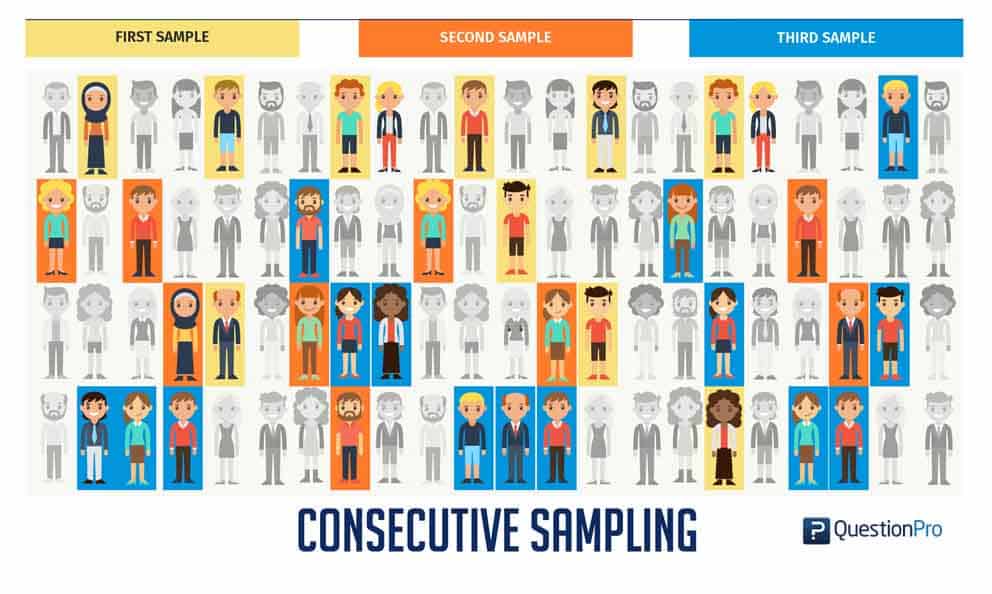 Reading Time: 3 minutes read
Reading Time: 3 minutes readConsecutive sampling: Definition
Consecutive sampling is defined as a non-probability sampling technique where samples are picked at the ease of a researcher more like convenience sampling, only with a slight variation. Here, the researcher selects a sample or group of people, conducts research over a period, collects results, and then moves on to another sample.
This sampling technique gives the researcher a chance to work with multiple samples to fine-tune his/her research work to collect vital research insights.
In most of the sampling techniques in research, a researcher will finally infer the study by concluding that the experiment and the data analysis will either accept the null hypothesis or disapprove it and accept the alternative explanation.
A null hypothesis means a statistical theory in which no significant difference exists between the set of variables involved in the research or experiment. In the mathematical terms, the original or default statement is often represented by H0. If the null hypothesis is accepted, then a researcher will not make any changes in opinions or actions. The null hypothesis is indirect or implicit data.
An alternative hypothesis is the opposite of the null hypothesis. In this statistical hypothesis, there is a relationship between the two variables involved in the study or research. An alternative explanation is accepted when a null hypothesis is rejected. An alternative hypothesis the testing is direct and explicit. H1 denotes an alternative theory.
However, in consecutive sampling, there is a third option available. Here, a researcher can accept the null hypothesis, if not the null hypothesis, then its alternative hypothesis. If neither of them is applicable, then a researcher can select another pool of samples and conduct the research or the experiment once again before finally making a research decision.
LEARN ABOUT: Survey Sampling
Consecutive sampling example
Here is an easy to understand example of consecutive sampling
- One of the most common examples of a consecutive sample is when companies/ brands stop people in a mall or crowded areas and hand them promotional leaflets to purchase a luxury car.
- In this example, the people walking in the mall are the samples, and let us consider them as representative of a population.
- Now, the researcher hands these people an advertisement or a promotional leaflet. A few of them agree to stay back and respond to the questions asked by the promotion executive (we can consider him/her as a researcher).
- The responses are collected and analyzed, but there is no conclusive result that people would want to buy that car based on the features described in the leaflet.
- The promotion executive now asks questions to another group of people who analyze the details of the car and its features and show a keen interest in buying the luxury car. Thus, this group of people has provided conclusive results for purchasing the vehicle.
However, there is a downside to this sampling method. You cannot consider the sample to be representative of the entire population. In this example, not all people who have taken this leaflet were interested in buying the car.
Here is where sampling bias comes into the picture. So to overcome this bias, consecutive sampling should be used in tandem with probability sampling.
LEARN ABOUT: Sampling Frame
Advantages of consecutive sampling
Here are the four advantages of consecutive sampling
- In a consecutive sampling technique, the researcher has many options when it comes to sampling size and sampling schedule. The sample size can vary from a few to a few hundred, that the kind of range of sample size we are talking about here.
- In this sampling technique, sampling schedule is completely dependent on the nature of the research, a researcher is conducting. If a researcher is unable to obtain conclusive results with one sample, he/she can depend on the second sample and so on for drawing conclusive results.
- In consecutive sampling, a researcher can fine-tune his/her researcher. Due to its repetitive nature, minor changes and adjustments can be made right at the beginning of the research to avoid considering research bias.
- Very little effort is needed from the researcher’s end to carry out the research. This technique is not time-consuming and doesn’t require an extensive workforce.







